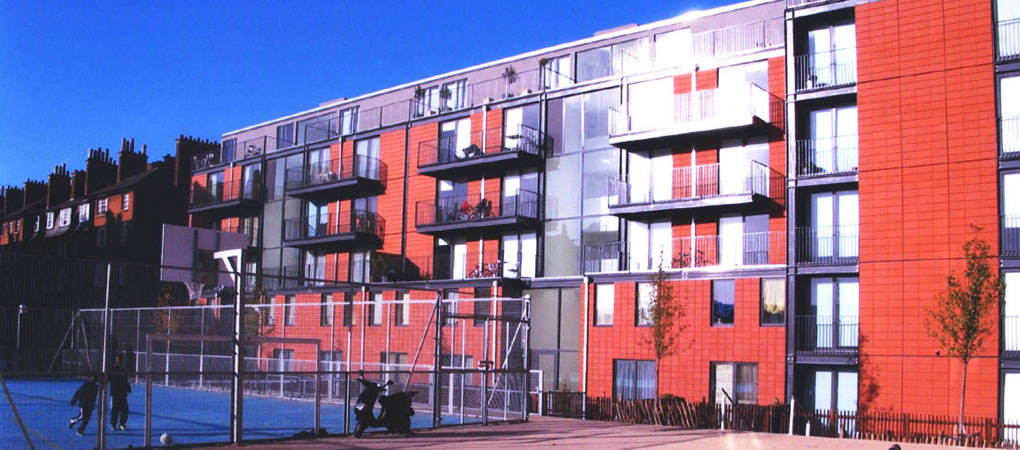Project Description
Aims and Objectives
- To provide modern affordable accommodation in the Fulham area of London.
- To provide socially sustainable mixed tenure accommodation built to high environmental standards.
- To promote greater social interaction and sense of community amongst residents through the provision of various community facilities.
The background to the development of the Beaufort Court project is the lack of affordable housing in the centre of London for a range of needs, including those living in overcrowded conditions, key workers and formerly homeless people. The project also addresses the issue of the national housing shortage in the UK by providing good quality housing at high density.
The project is developed by Fielden Clegg Bradley, an internationally recognised architectural practice that was established in 1978. Since inception, the practice has established a reputation for strong social and environmental principles. In 2003, it won the Building Award’s Architectural Practice of the Year, a Queen’s Award for Sustainable Development and the Civic Trust’s Sustainability Award. With an expansion in the scale of projects undertaken by the firm, its traditional expertise of environmental design, community projects and conservation are now being included in broader urban regeneration projects.
The Beaufort Court project is a mixed tenure scheme for people on low incomes, key workers who cannot afford to buy a house, large families who live in overcrowded conditions and former homeless people whose housing needs are being addressed by the Rough Sleepers Initiative.
The scheme provides 65 units of housing on a restricted urban site of 0.53 hectares. It is high density with 365 habitable rooms, 122 dwellings per hectare located within an active area of residential, retail and commercial uses. The current government density guidance is 30 – 50 dwellings per hectare, with the average for construction of new dwellings currently at 25 dwellings per hectare. There are 19 shared ownership dwellings, 28 social rented dwellings, 14 dwellings allocated for key workers and four provided as part of the West London Rough Sleepers’ Initiative. Unit size ranges from one-bedroom flats to large family houses. New communal facilities, including a Residents’ Hall and an all-weather sports court have been provided. These are shared with the adjacent Peabody Estate built in 1912 and serve to integrate the two developments.
The accommodation is arranged in three blocks around an open courtyard. Car parking facilities are provided beneath the all-weather sports court. Private outdoor space is provided for every dwelling, thus giving an opportunity for relaxation, which residents rarely had in their previous accommodation. Tenants of both the new and old estates enjoy the shared court, which provides a landscaped view and forms an enclave away from the busy road.
It is the first social housing project in the UK to incorporate three off-site fabrication approaches in one scheme. It is also one of the first significant projects to reach completion using the PPC 2000 partnering contract, a concept that depends on everyone sharing a sense of co-ownership of the project. All consultants and specialists involved in the project as well as the Peabody Trust were members of the partnering team.
Tenants on the existing Peabody Estate were consulted regarding the design by means of presentations made to the Residents’ Association and by individual meetings with tenant representatives. The original designs were refined and amended to reflect existing tenants’ and housing management concerns. Occupational therapists advised on the design of apartments for wheelchair users and the local police provided advice on developing the Secured by Design elements of the project.
Construction commenced in March 2002 and was completed in July 2003. This is estimated to be 16 weeks quicker than usual due to the prefabricated construction methods used. The project has made a positive contribution to the regeneration of the urban area. The design of the project maximises the surveillance through the way people live and interact with each other rather than using gated communities or CCTV cameras.
The capital cost of construction was £7.5 million excluding land, which represents a construction cost of £1,250 per m2, which is typical for construction of more than two storeys in urban areas. This was funded by the Housing Corporation with £3.2m social housing grant and £600,000 of SRB key worker funding under the ‘Keep London Working’ programme. The remainder coming from capital receipts, rental income and Peabody Trust reserves. Future revenue funding will come from rental income on the properties and a range of subsidy support.
Why is it innovative?
- The first social housing project in the U.K. to incorporate three off-site prefabrication approaches in one scheme.
- The light gauge steel panelled approach provides flexibility in design and minimises transportation costs and difficulties of access to an inner city site. This minimised the structural weight and gave savings in foundation costs.
- The use of hot-rolled panels in the structural system provides additional design flexibility and the ability to prefabricate a unique rain screen system, permitting large floor to ceiling window openings and extensive balconies.
- Load-bearing volumetric bathroom pods eliminate the construction height normally associated with modular construction.
- Innovative and stylish design typical of high cost private sector developments has been used to provide affordable housing.
- The project has provided open space and private amenity space in the form of gardens and balconies that many residents had not enjoyed before.
- The project has created a high quality urban environment for a wide range of people, creating a much greater sense of community.
- Provision of modern, well-constructed and comfortable living accommodation.
What is the environmental impact?
A brownfield site was used for the development that has included tree planting and sedum roofs.
Light gauge and hot-rolled steel construction ensure maximum future recycling capability and low embodied energy. Transportation costs are reduced as many of the components are manufactured off-site and brought in and assembled by crane.
SAP ratings, thermal and sound insulation all exceed current standards. Sedum roofs have been provided where possible to reduce rainwater runoff and passive solar design is used to encourage natural systems of heating and cooling.
Is it financially sustainable?
The project has used conventional social housing funding both for capital and revenue expenditure and has been cited by the funding agency (Housing Corporation) as a model for affordability. The families on modest incomes who are able to purchase their homes on a shared ownership basis are given the opportunity to increase their personal wealth.
High density, low-cost construction has improved the affordability of housing in this high cost area of London. The average selling price for the 19 shared ownership dwellings was £115,000 (July 2003).
What is the social impact?
The adjacent Peabody estate had little amenity space and the shared provision with the new development of a Residents’ Hall and sports facilities provides space to play, relax and gather which combine to give the scheme a sense of place and improve the opportunity for social interaction and integration. A joint Residents’ Association has been established and is very active, organising sports and social activities. The area is kept clean and tidy, reflecting the value that people living here have placed upon their surroundings. The community facilities are well used by all and have proved very successful.
A Secure by Design approach was developed in cooperation with the local police and has resulted in a safer urban environment. Although there were a few anti-social behaviour incidents in the beginning that were typical of both the area and a new building development, there are now fewer such incidents than average for this particular part of London.
The mixed tenure scheme brings together a range of income groups with shared ownership, key worker, social renting and formerly homeless people living in the same project. There are no differences in the specification of the appearance or internal fit of the apartments and homes across the tenure. The high quality of the scheme materials and detailing are seen as a vital component of social sustainability, in terms of creating places that people want to live in. Residents are encouraged to become involved with the Residents’ Association which manages the community facilities.
Barriers
The use of the new partnering process was a significant change from previous project management practices and adjustment to previous ways of working had to be made. The difficulties inherent in using this new approach were overcome by having an inspired and effective team committed to the principle of working together and giving a positive example of what can be achieved with good will on all sides.
Lessons Learned
- Dimensional co-ordination among the design team is critical to success when using off-site fabrication building methods.
- Developing new products such as bathroom pods is a lengthy process.
- The learning curve can be steep and the main value in off-site construction methods is in repeating the process for future products.
Transfer
Having received the Gold Standard for quality of design and accreting sustainable communities, the project is used as an exemplar scheme for the Building for Life, the Commission for Architecture and the Built Environment, the House Builders Federation and the Civic Trust. It also provides a successful example of the practices recommended in Rethinking Construction and the Egan report.
The project has generated significant interest within the architectural world, the housing industry and the general public. Many architects and housing clients have visited the scheme. The particular areas of interest are the innovative construction techniques and the mix of tenure. The Housing Minister, Lord Rooker, has visited the scheme, as have representatives of Rotterdam Town Council.
The Peabody Trust has used the modular approach or affordable housing solutions and applied it in a number of designs for recent and future housing developments such as Baron’s Place in London SE1 and Raines Court in N16. A new development at Harrow Road is also planned using the experience gained from the lessons learned in this project.
Partnership
Professional, NGO, Private Sector



